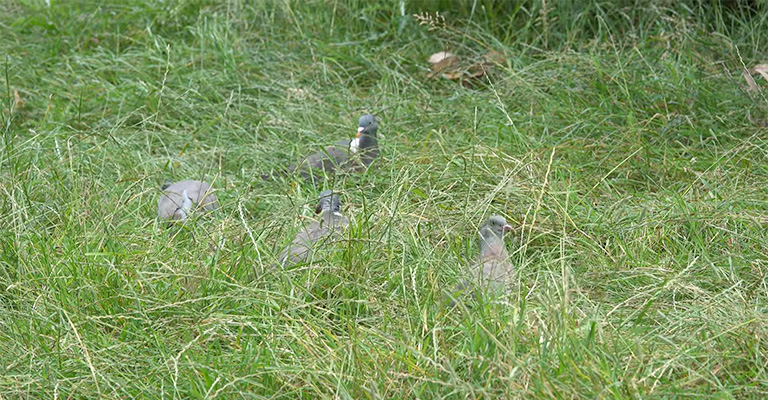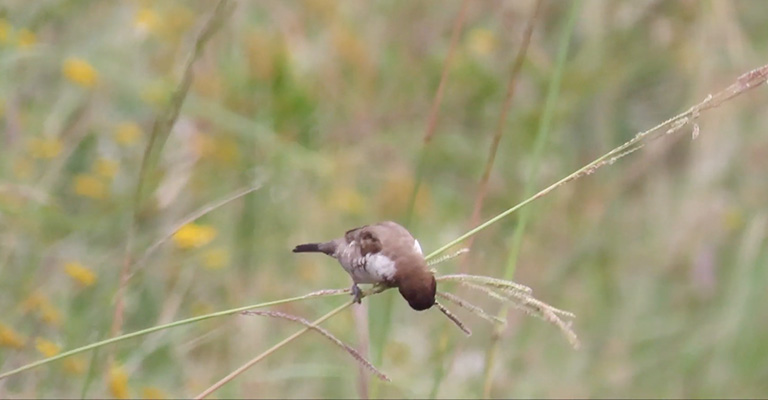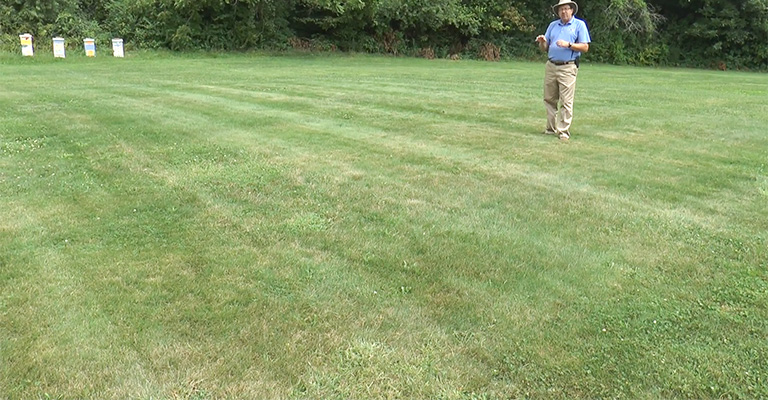Maintaining a lush, green lawn begins with the successful germination of grass seeds. However, an age-old challenge arises when birds view freshly sown grass seeds as an irresistible feast.
Their voracious appetite can disrupt the carefully laid groundwork for a vibrant lawn.
Effectively deterring birds from indulging in this seed buffet requires a thoughtful combination of strategies that balance the needs of your garden and the habits of these feathered visitors.
From visual deterrents that startle to tactical timing that leverages their routines, there are numerous ways to safeguard your grass seeds from becoming a bird’s culinary delight.
By understanding how to keep birds from eating grass seeds, you can ensure that your grass seeds have a fighting chance to thrive.

How To Keep Birds From Eating Grass Seed? [9 Amazing Ways]
Certainly, here are nine methods to keep birds from eating grass seed, each with a brief paragraph description:
Netting
Covering freshly sown grass seed with bird netting is a highly effective way to prevent birds from reaching the seeds. The netting creates a physical barrier that discourages them from landing and pecking at the seeds.
Ensure that the netting is securely fastened and doesn’t sag, as birds may find ways to get underneath if not properly installed.
Scare Tactics
Placing visual and auditory deterrents in the area can deter birds. Items like reflective tape, aluminum foil strips, or old CDs can create flashes of light that birds find unsettling.
Wind chimes, motion-activated sound devices, or even a fake owl can introduce unexpected noises and movements that make the birds wary.
Predator Decoys
Using decoys like plastic or wooden owls, hawks, or even scarecrow-like figures can give birds the impression that predators are present in the area.
Be sure to move these decoys occasionally to prevent birds from realizing they are not a real threat.
Repellent Sprays
Applying bird repellent sprays to the seeded area can deter birds through smell and taste. These sprays often contain natural or synthetic compounds that birds find unappealing.
Remember to reapply the spray after rain or as directed on the product label.
Physical Barriers
Installing barriers like mesh or row covers directly over the seeded area can provide protection while allowing sunlight and moisture to reach the seeds.
These barriers can be especially useful during the initial germination stage when the seeds are most vulnerable.
Companion Plants
Planting bird-friendly plants elsewhere in your garden can divert birds’ attention away from the grass seeds.
They might be more attracted to these alternative food sources, reducing the likelihood of them targeting freshly sown seeds.
Mulching
Applying a thin layer of straw or mulch over the grass seeds can make them less visible and accessible to birds.
This can also help retain moisture and promote germination while deterring birds from pecking at the seeds.
Timing
Sow grass seeds when bird activity is relatively low, such as early in the morning or late in the afternoon.
Birds are more active during midday, so planting during quieter times can reduce the chances of them discovering the seeds.
Feeding Stations
Set up bird feeders in a separate area of your yard, away from the newly seeded area.
By providing birds with an alternative food source, you can help ensure they’re less motivated to search for food in your freshly sown grass seeds.
Remember that different bird species may respond differently to these methods, so you might need to experiment with a combination of approaches to find the most effective solution for your specific situation.
Why Are Birds Eating My Grass Seeds?

Birds are eating your grass seeds for a variety of reasons, driven by their natural behaviors and instincts.
Here’s a breakdown of potential reasons, each with a paragraph description:
Food Source
Birds view grass seeds as a readily available and nutritious food source. Seeds provide essential nutrients and energy, especially during periods when their usual diet might be scarce.
The small size of grass seeds makes them an easy and convenient option for many bird species.
Instinctive Foraging
Foraging is a fundamental behavior for birds to find sustenance in their environment.
They have evolved to explore and exploit various food sources, including seeds, as part of their survival strategy. The presence of exposed grass seeds may trigger their instinct to investigate and consume them.
Nesting Material
Some bird species use grass seeds and other plant materials as nesting material. They might be collecting seeds to line their nests or provide a comfortable substrate for their eggs.
This behavior can be particularly common during breeding seasons.
Environmental Conditions
Birds are more likely to forage intensively during certain times, such as after a rain shower or during drought conditions.
Rain can expose buried seeds, while drought might lead birds to search for alternative food sources, including grass seeds.
Social Learning
Birds are known to learn from one another. If one bird discovers that grass seeds are a suitable food source, nearby birds might observe this behavior and join in.
This can lead to a cascade effect where more and more birds begin to feed on the seeds.
Lack of Alternatives
If your yard doesn’t offer a wide variety of other food sources, birds might be more inclined to target the grass seeds.
Providing alternative food options, like bird feeders with appropriate seeds or insects, can help redirect their attention.
Migration Behavior
During migration, birds may alter their feeding habits due to changes in their environment.
If your area becomes a stopover point for migrating birds, they might consume grass seeds as a temporary food source before continuing their journey.
Unprotected Seeds
If grass seeds are freshly sown and not properly covered, they’re easily accessible to birds.
The exposed seeds are more likely to attract attention and become a quick meal for opportunistic foragers.
Seasonal Variation
Different bird species have varying diets based on the time of year. Some species might focus more on seeds during certain seasons, and if this coincides with the time you’re planting grass seeds, it could lead to increased consumption.
Understanding these factors can help you develop more effective strategies to deter birds from eating your grass seeds.
Implementing a combination of approaches, like using netting, scare tactics, and providing alternative food sources, can significantly reduce the impact of bird feeding on your newly seeded area.
Are There Any Grass Seeds That Birds Won’t Eat?

While no grass seeds are entirely immune to bird consumption, some grass varieties are less appealing to birds due to their size, texture, or taste.
Here are a few examples of grass seeds that are generally less attractive to birds, each with a brief paragraph description:
Fine Fescues
Fine fescue grass seeds, such as creeping red fescue, chewings fescue, and hard fescue, have very fine and slender seeds.
Their smaller size and delicate texture can make them less appealing to larger bird species. These grasses are often used in shady or low-maintenance areas.
Bahiagrass
Bahiagrass seeds are relatively tough and have a coarse texture. This characteristic can make them less palatable for many birds.
Bahiagrass is commonly used in warm-season lawns and pastures, particularly in areas with sandy or infertile soils.
Buffalograss
Buffalograss seeds are small and have a unique shape with a pronounced awn, which might deter some birds.
Buffalograss is a warm-season grass known for its drought tolerance and low-maintenance requirements, making it less likely to attract bird attention.
Zoysia
Zoysia grass seeds are relatively small and have a tough outer husk. This can discourage birds from consuming them.
Zoysia grass is known for its dense growth and heat tolerance, making it a common choice for lawns in warm climates.
Seashore Paspalum
Seashore paspalum grass seeds have a hard seed coat that can deter birds. This grass is often used in coastal areas due to its salt tolerance and ability to thrive in salty or brackish soils.
Centipedegrass
Centipedegrass seeds are small and have a thin seed coat. While they might still be consumed by birds, their smaller size and structure can make them less attractive.
Centipedegrass is known for its low-maintenance nature and ability to grow in acidic soils.
Zoysia
Zoysia grass seeds are relatively small and have a tough outer husk. This can discourage birds from consuming them.
Zoysia grass is known for its dense growth and heat tolerance, making it a common choice for lawns in warm climates.
Clover Mixtures
Planting a grass-clover mixture can also help discourage birds. Clovers have a unique growth habit and produce nitrogen-rich nodules in the soil, which can deter birds from targeting the grass seeds in the mix.
Remember that while these grass varieties may be less appealing to birds, individual bird behavior can still vary.
Combining strategies like using bird netting, scare tactics, or providing alternative bird feeders can further reduce the risk of bird consumption and promote successful grass seed establishment.
FAQ
To deter birds, try covering the seeded area with bird netting. Secure the netting tightly to prevent birds from reaching the seeds.
This physical barrier disrupts their access and protects the seeds during the vulnerable germination stage.
Yes, you can use bird-repellent sprays with natural or synthetic compounds. These sprays create a taste or scent that birds find unpleasant, deterring them from consuming the grass seeds. Reapply after rain or as needed.
Scare tactics can work well initially, but birds might eventually become accustomed to them.
To maintain their effectiveness, periodically move the decoys or alternate with other visual and auditory deterrents to prevent habituation.
Yes, consider planting bird-friendly plants in other areas of your garden to divert birds’ attention.
They might be attracted to these alternative food sources, reducing the pressure on your grass seeds.
Sow grass seed during periods of lower bird activity, such as early morning or late afternoon.
Birds tend to be more active during midday. Planting during quieter times reduces the chances of them discovering and feasting on freshly sown seeds.
Conclusion
In the delicate dance of cultivating a flourishing lawn, the challenge of deterring birds from devouring freshly planted grass seeds is a familiar one.
Through the array of strategies presented, from physical barriers to avian psychology-based solutions, it becomes evident that there is no one-size-fits-all answer.
Instead, the art lies in creating a tailored defense that respects the environment, the birds, and your desired outcome. As you embark on this endeavor, remember that patience and adaptability are your allies.
With a balance of persistence and innovation, you can transform your lawn into a vibrant canvas of green, undisturbed by the appetites of our feathered friends.
In the quest to keep birds from eating grass seed, your garden becomes a testament to the harmonious coexistence between nature’s inhabitants and the beauty we strive to cultivate.